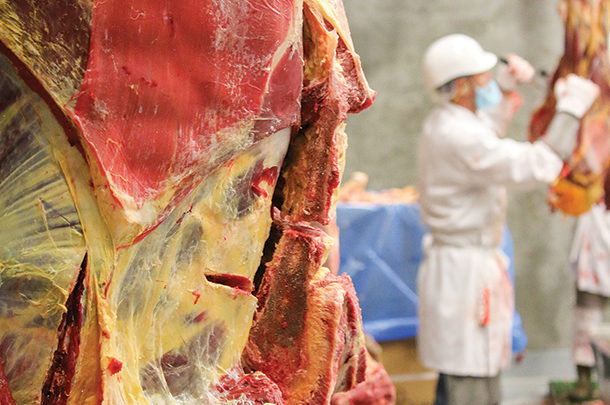Creating a line more heavily automated with robotic technology is one solution on the table grabbing the attention of leaders in agriculture and technology.
Prior to the pandemic, the U.S. was capable of processing about 124,000 cattle a day. In the month of April, it dropped to only 80,000 head; as of August, numbers were back up to 115,000-116,000 a day – still falling about 8,000 or 9,000 head behind the potential.
In America, one of the best examples of increased automated systems is in the poultry industry, where machinery has taken over multiple segments of processing. On the global scale, particularly in Europe, a lot of technology has stepped up into hog and lamb processing, considerably more so than in the U.S. But beef is a bit more of a unique case, and the discussion on human versus automated processing isn’t so simple.
Barriers in beef
Some of the most intricate machining work you’ll find at a beef processing plant is likely to be found at the final stage in packaging. Down the processing line, you will see the majority of deboning, cutting and trimming is all done by hand, from the initial large carcass cuts all the way from high dollar cuts to cold cuts.
“Fundamentally, on the slaughter line, minimal automation is being used, and the primary reason is because of extreme variability in animal dimension,” explains Dr. Ty Lawrence, a professor of animal science at West Texas A&M University. Unlike poultry and hogs, beef carcasses come in a much wider range of sizes with varying amounts of fat and muscling, making it more difficult for a machine to repeat the exact same process repeatedly. “Lots of animals of varying shapes and sizes can be processed with a robot and photo eye, but you can’t do it at the speed at which U.S. processing takes place.”
He notes more automation exists in European processing facilities, but they still run at a much slower pace compared to the U.S., an unacceptable compromise at this point in the food supply system.
Another serious roadblock to installing and utilizing robots is the availability of space within building confinements. The structural foundation of most beef plants is very old compared to the poultry industry. Robots needing room to properly move and function alongside human workers poses a serious risk and, in some cases, physical impossibilities.
Working with the internet technology (IT) world
Robotic systems on the cusp of cutting-edge technology are certainly beyond the scope of plant managers and operators. Unlike a lot of live animal handling equipment born and crafted by industry academia, machinery on the cutting line must come from the world of engineering and technology far outside the sphere of the ag world.
“There’s been an upswing in programmers and robotics builders, high-tech people that suddenly have an awareness and interest in the food industry, where they didn’t even know the technology existed before,” says Don Close, senior animal protein analyst with Rabo AgriFinance.
Operating and servicing robotic equipment is another big uncertainty at this time. When it comes to meat-packing-specific technology, nearly all manufacturers are based overseas in Europe. This makes it difficult to get parts delivered in a timely manner when something breaks down. Many of the minds with the education background and training to service and maintain such equipment tend to be located in large cities or the Silicon Valley.
“To have people with that level of technology education and then to talk that person [in]to living in the rural U.S. and working daily in that environment is difficult,” Close notes. “There’s a mentality, ‘I didn’t go through all that education to work in a beef plant in rural America.’”
Major packers such as Cargill are already looking for ways to close this gap.
“The future of protein will absolutely include automation. We’ve already seen these advances in grading, packing and plant logistic technology at work,” says Daniel Sullivan, media relations director for Cargill Protein and Animal Health, noting North America already boasts some of the most efficient protein production in the world. “We’re in Silicon Valley regularly and talking with innovators nearly every month, making sure we have the latest insight that help [us] focus on people and food safety, address labor shortages and ensure we deliver for customers and consumers.”
It would appear another of the big four, JBS, is thinking along those very same lines. A 2016 article from National Public Radio, noted late that year JBS bought a large controlling share of the New Zealand-based robotics manufacturer Scott Technology. Scott Technology has already produced advanced processing technology for packers throughout Europe. Both companies were unable to provide updated comments on the current situation.
Tyson Foods was also unable to provide comments for this article. However, an article featured in The Wall Street Journal this July indicated there was movement from the company’s Springdale, Arkansas, headquarters, investing more into engineers and scientists for more automated technology.
The labor discussion
An issue at the heart of meatpacking today is labor, which continues to be a hot button issue, with or without COVID-19. Are robotics truly economically sustainable, realistically feasible and superior to the human hand?
COVID-19 has revealed the vulnerabilities of a human workforce, subject to individuals getting ill, health and safety restrictions and employees leaving in hard times. Lawrence notes a lot of employees left at the beginning of COVID-19 simply because it was optimal for early retirement. More automation means less issues in this area but again leaves open issues for service and maintenance.
Pre-COVID-19 there was also the mounting issue of increased immigration conflicts and concerns. To keep the flow smooth and consistent, the big packers rely heavily on plenty of affordable and available labor. In one perspective, it would seem robotics would be an answer due to consistency and eliminating labor costs.
“I think we are at, and have been for a while, that tipping point of the cost benefits and efficiency and the growing difficulty of labor,” says Close. “That’s particularly true if you take the limitations and constraints that we’ve had on immigration in recent years; it exasperated the whole situation.”
The flipside of this is there certainly is a need for highly trained professionals to manage and service robotics, and either having personnel on-site or flown in certainly comes with a price tag.
Lawrence recalls a time when there was some automation in leg cutting on beef carcasses he saw in the mid-1990s. As of today, he’s not aware of any location currently utilizing such machinery.
“I suspect the maintenance cost of that machine did not bear the cost of efficiency to remove human labor,” he says, noting he has heard of an automated carcass splitting system in a prototype phase currently being evaluated.
But Lawrence is personally doubtful the labor situation will be fixed by robotic automation anytime soon.
“If beef processors thought that was the case, the processors would have already reached out to equipment manufacturers,” he says.
It is true that while much of the technology and parts manufacturing is overseas, there are multiple engineering corporations in the U.S. who would be capable of custom creating such systems, if they were requested by packers.
While how near or far off in the future enhanced packing technology might be, the discussion is certainly not going away. Undoubtedly, the ever-changing political, social and economic climates in the U.S. will continue to have a close hand in the way the packing sector caters to consumers.








